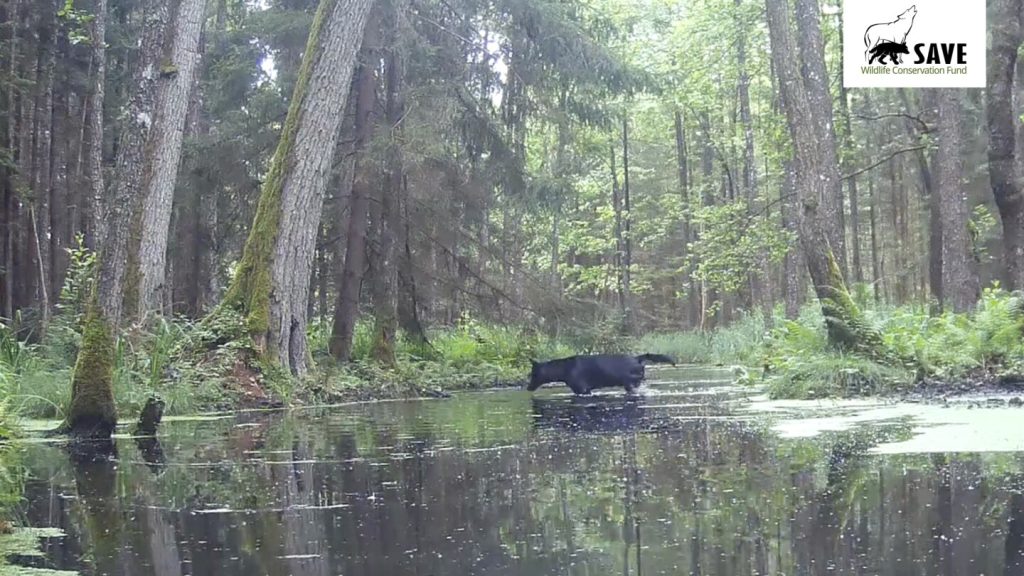Rare Black Wolves Spotted in Polish Forest: A Conservation Breakthrough
In a remarkable discovery, two rare black wolves, believed to be siblings, were recently captured on camera in a Polish forest. The footage, taken by a conservation organization, has sparked excitement among wildlife experts and the public alike. The sighting was made possible by Joanna Toczydłowska, a project coordinator for the SAVE Wildlife Conservation Fund Poland, who had initially set up the camera to study beavers. Instead, she found herself recording something far more extraordinary: rare black wolves crossing a stream in the forest.
The video clips, captured over the past year, show the wolves navigating the forest landscape. In one clip, a black wolf and a gray wolf are seen crossing a stream, the water reaching almost up to their bellies, before they leap onto the bank. In another clip, taken last fall, two black wolves and a gray wolf are seen fording the same stream. These sightings have not only excited conservationists but have also raised questions about the genetic makeup of these rare animals.
The Genetic Mystery of Black Wolves
The majority of Poland’s wolf population, estimated to be between 2,500 and 3,000 individuals, are gray wolves with red or black accents. Black fur, however, is a rare occurrence in European wolves, resulting from a genetic mutation that is believed to have originated in domesticated dogs thousands of years ago. This mutation, while rare in Europe due to reduced genetic diversity, is more common in other parts of the world. For instance, in Yellowstone National Park in the United States, at least half of the wolf population has black fur.
The genetic diversity of wolves in Europe is limited compared to other regions, making the sighting of black wolves in Poland particularly significant. Conservationists are eager to learn more about the genetic background of these wolves, which could provide valuable insights into the history and evolution of wolf populations in the region. To achieve this, the SAVE Wildlife Conservation Fund Poland is collecting scat (wolf droppings) from the forest to conduct genetic testing. This effort could unlock the secrets behind the black fur mutation and its prevalence in Poland.
The Conservation Efforts and the Importance of Education
The SAVE Wildlife Conservation Fund Poland has been monitoring wolf populations in the country for over 13 years. The organization’s efforts are not only focused on studying and protecting wolves but also on educating the public about these majestic creatures. Wolves were nearly extinct in Poland by the 1950s, but their population has begun to recover in recent years, particularly in the central part of the country since the early 2000s.
Roman Gula, head of the organization’s wolf monitoring project, emphasized the importance of education in wolf conservation. "For people, it is a new phenomenon," he said. "Education is one of our major, major goals." By teaching the public how to safely coexist with wolves, the organization aims to reduce human-wolf conflicts and promote a greater understanding and appreciation of these animals.
The organization is also working to protect the wolves from poaching and misinformation. For this reason, they have not disclosed the exact location of the forest where the black wolves were spotted. By keeping the location secret, they hope to prevent the spread of false information and protect the wolves from potential threats.
The Sighting and Its Significance
The sighting of the two black wolves is a significant event for wolf conservation in Poland. Both wolves are estimated to be around 30 kilograms (66 lbs) in weight, roughly the size of a German shepherd, and are believed to be about a year old. Based on their size and behavior, Toczydłowska suspects that they are siblings and likely part of a larger family group. At least one of the wolves is confirmed to be male.
The fact that both wolves are black suggests that they share a common genetic background, which could indicate that the genetic mutation responsible for their fur color is present in their family lineage. This makes the sighting not only rare but also scientifically valuable. The conservation organization hopes that the genetic testing of the scat they collect will shed light on the origins of this mutation and its prevalence in the Polish wolf population.
A Call to Action for Conservation
The SAVE Wildlife Conservation Fund Poland has announced the sighting on their Facebook page and is calling for financial support to help cover the costs of genetic testing. By funding this research, the public can contribute to a better understanding of Poland’s wolf population and the rare genetic traits that make these black wolves so unique.
The organization’s plea for support highlights the importance of public involvement in wildlife conservation. By donating to such initiatives, individuals can play a direct role in protecting endangered species and advancing scientific knowledge. The sighting of the black wolves serves as a reminder of the beauty and diversity of Poland’s wildlife, and the need to protect it for future generations.
Conclusion: A New Chapter for Wolf Conservation
The discovery of the rare black wolves in Poland is a landmark moment in the country’s wolf conservation efforts. It not only offers a glimpse into the genetic diversity of Poland’s wolf population but also underscores the importance of education and public involvement in protecting these animals. As the SAVE Wildlife Conservation Fund Poland continues its work, the hope is that this sighting will inspire further research and action to ensure the survival of wolves in Poland and beyond.
The story of the black wolves is a testament to the resilience of nature and the impact of conservation efforts. By learning more about these animals and the challenges they face, we can work towards a future where wolves and humans coexist peacefully. The rare sighting of the black wolves in Poland is a reminder of the beauty and wonder of the natural world, and the need to protect it for generations to come.












